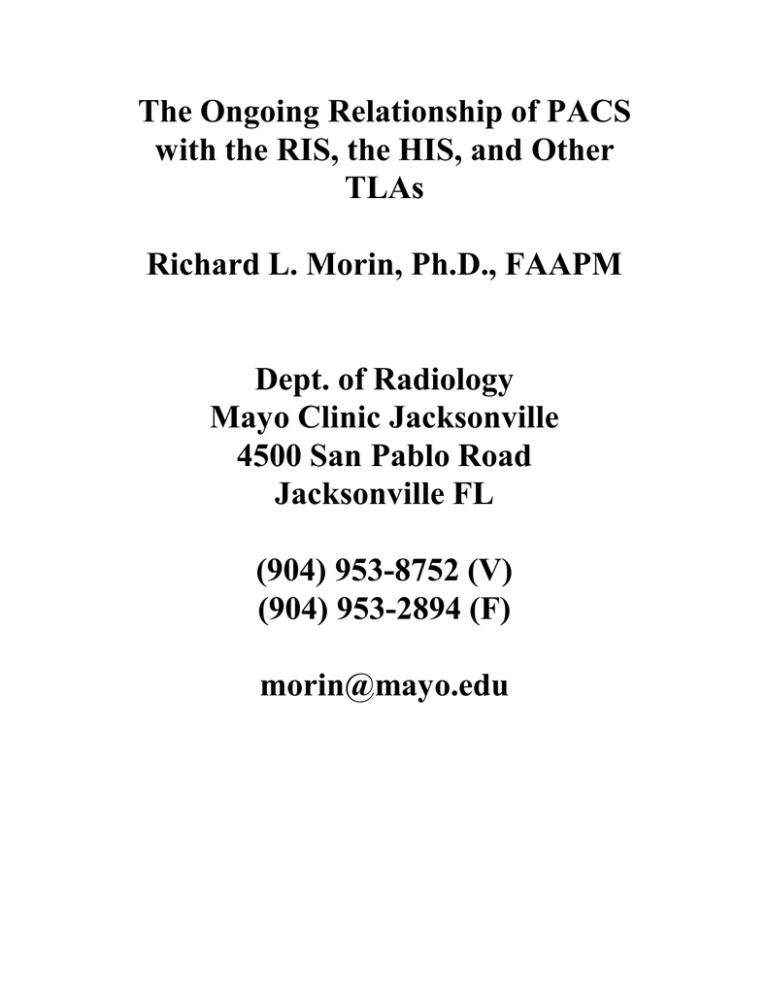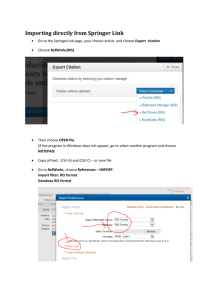The Ongoing Relationship of PACS TLAs
advertisement

The Ongoing Relationship of PACS with the RIS, the HIS, and Other TLAs Richard L. Morin, Ph.D., FAAPM Dept. of Radiology Mayo Clinic Jacksonville 4500 San Pablo Road Jacksonville FL (904) 953-8752 (V) (904) 953-2894 (F) morin@mayo.edu INTRODUCTION: PACS is not an island. An electronic radiology practice can be characterized as demonstrated in Figure 1. Image Management and Interpretation Image Acquisition Electronic Radiology Practice EMR HIS Figure 1 RIS Diagram of the electronic radiology practice and its components. Image acquisition combined with image management and interpretation are generally considered together as the Picture Archive and Communication System (PACS). The communication of the PACS with the other electronic systems in the radiology department and institution is essential to fully realize the implementation and benefit afforded by automation. Even though the effect of PACS is far greater outside the radiology department, the function of PACS within the department can be markedly different depending upon the proper design and function of these interfaces. It is not often appreciated that the full realization of efficiency and expense reduction is dependent upon these active communications. In this chapter, we shall examine the nature and design of the interfaces which allow PACS to become a corner stone of the electronic radiology practice. We shall proceed with this examination, using as a model the electronic radiology practice at Mayo Clinic Jacksonville. We shall begin with a brief description of the practice and motivation for the electronic radiology practice and proceed with the design and function of these interfaces, with particular attention to the clinical experience gained over the last few years. PRACTICE DESCRIPTION The medical practice at Mayo Clinic Jacksonville is performed at two primary sites: Mayo Clinic Jacksonville and St. Luke’s Hospital. In addition, there are nine additional Family Medicine practices, which refer patients to the primary locations, some of which provide radiology imaging. The staff consists of 215 physicians covering 23 medical and 12 surgical specialties, respectively. Approximately 200,000 patients visits occur each year. Approximately 40% of patients come from Jacksonville/North Eastern Florida area, 30% from the rest of Florida, 26% from the rest of the United States, and 4% from international locations. The practice at the hospital, in addition to Mayo physicians, consists of approximately 200 community physicians, which supply services in a facility licensed for 279 beds and providing all medical specialties except for pediatrics. The average length of hospital stay is approximately 5 days. The radiology practice consists of 19 radiologists, 2 fellows, and approximately 117 technologists and support personnel at both sites. The department volume is approximately 180,000 exams per year with approximately 120,000 being performed at the clinic. The motivation for the implementation of electronic imaging stemmed from a desire to increase efficiency while decreasing expenses. The previous screen film based practice was very efficient from the referring physicians perspective. The chest examination (original film plus report) was available to the referring physician within 45 minutes of the completion of the exam within the department. Standard radiography exams were routinely available within 60 minutes and specialty exams (CT/MRs/US/NM) were available within 120 minutes. Upon special request, certain examinations such as orthopedic studies were available to the referring physician within 15 minutes following the completion of radiography. The major difficulty was that this efficiency was not without a cost. The largest component of that were the personnel expenses due to the fact on average 8 different person handled the film form the radiologic technologist to the referring physician. Hence, the motivating factor to implement this style of practice was to reduce cost and simultaneously improve an already very efficient process. AUTOMATED RADIOLOGY PRACTICE Prior to the implementation of the electronic imaging practice design and implementation, the clinic had embarked upon a project to eliminate the paper medical record and its transportation throughout the facility and institutional system. This project was termed the Automated Clinical Practice (ACP). This identification was chosen to reflect the fact that the implementation of electronic medical record was not meant to be simply an electronic facsimile of the paper medical record, but rather a change in practice involving physicians, nursing and desk staff, as well as all other support services. In order to parallel this activity and express the same sentiment, the implementation of the electronic imaging in radiology was termed the Automated Radiology Practice (ARP). The project was envisioned as demonstrated in Figure 2. Electronic Imaging- Mayo Clinic Jacksonville ACP no changes images via “floor server” ARP (compressed images by 1:8, 8bit) images PACS R IS Patient demographics orders, results, prefetching - information, image routing information (radiology to floors and floor to floor transfers) Integrated PACS & RIS & EMR Figure 2 Diagram of the components and data interchange or the automated radiology practice The design and implementation of the PACS must be closely and intimately interconnected to the ACP as well as the already established Radiology Information System (RIS). As seen in Figure 2, there was envisioned a deal of information flow between the RIS and PACS, as well as primarily image flow between the ACP and PACS. The high level of interconnection already established between the ACP and RIS would continue without significant change (particularly from the user perspective). A schematic representation of the PACS at Mayo Clinic Jacksonville is given in Figures 3 and 4. GE-CT Computed Radiography GE-MR Dig. Fluoro Other Chest Nuc-A Nuc-M US FG DICOM DICOM Ethernet MR, CT CT, MR Outside films CR CR Fluoro, CR US Nuc FDDI RIS File Servers (3 days storage) Laser cameras Optical disk jukeboxes (20 mo. storage) ACP MayoPACS Film Digitizer Archived & outside films Configuration in Radiology Figure 3 Configuration of the ARP within radiology A New data per day floor server ACP-workstation B procedures / MB 8th floor 58 / 1,439 7th floor 87 / 2,164 6th floor 72 / 1,800 5th floor 4th floor 35 / 874 3rd floor 41 / 1,025 US Nuc 2nd floor Radiology 343 / 8,581 Digital Archive (file servers & jukeboxes) St. Lukes Hospital 40 / 1,012 Configuration Figure 4 Configuration of the ARP at Mayo Clinic Jacksonville Figure 3 is a depiction of the devices and layout within the radiology department and Figure 4 demonstrates the activity and devices within the clinic building within the department (Figure 3). Conversion of radiography to computed radiography with interfacing to the institutional backbone was an essential first step. In addition, current existing systems for CT, MR, US, and Nuclear Medicine were to be interfaced via the Digital Imaging and Communication in Medicine (DICOM) standard. The data would then be interpreted via workstations (rather than light boxes) with subsequent transmission to electronic archives on magnetic disk, optical disk, and tape. In addition, image distribution throughout the facility (Figure 4) was to be accomplish by transmission upon completion to servers on each clinical floor, which would then provide images to the ACP workstation in each physician examination room or office (approximately 500 workstations). It is most important to point out that the single line connecting the RIS and ACP in Figures 3 and 4 actually became over 25 separate interfaces. A subset of these interfaces is presented in Table 1. Table 1. Sample of ARP-RIS-ACP Interfaces Device/Systems Fuji 9000 ↔ RIS Siemens Digiscan 2T ↔ RIS SIENET ↔ RIS SIENET ↔ RIS SIENET ↔ RIS Cerner ACP ↔ RIS ↔ SIENET Dejarnette ↔ RIS ↔ SIENET GE ↔ RIS GE ↔ RIS Acuson ↔ ALI ↔ RIS ADAC ↔ RIS Function Demographics to CR Reader Demographics to Chest CR System Reports to SIENET for display Radiology Pre-Fetch List Floor Server Pre-Fetch List Images to ACP Workstation Demographics to Digitizer Demographics to CT Demographics to MR Demographics to Ultrasound Demographics to Nuclear Medicine Method HL7 HL7 HL7 HL7 HL7 HL7 Bar-code Bar-code Bar-code Bar-code Bar-code We shall now examine the information and image flow which necessitates the design and function of these interfaces. DATA AND IMAGE FLOW There are two primary types of image flow: (1) the production of new images and their distribution for interpretation and clinical review and (2) the retrieval of prior images to radiologists for interpretation/comparison and to clinicians for patient consultation and review. To illustrate the data and image flow we shall examine the production and use of radiography images. An examination is ordered either through the ACP ordering software or through the RIS. An accession number is generated by the RIS. The order is sent by the RIS to a computer which can communicate with both the RIS and the ACP. This device is commonly called the PACS broker. Other terms for this device are: HIS broker or HIS/SCP (DICOM terminology). This device is capable of speaking a language which is a standard for hospital information systems (HIS) or electronic medical record systems (EMR) which is known as HL-7. This is an acronym for Health Level-7. In addition, the device can also communicate with the Radiology Information System either through HL-7 or DICOM. The necessity for such a brokering device is present at this time because the various HIS and RIS systems do not have embedded and inherent communication with one another. Upon patient arrival, the order is updated on the broker to capture any changes in demographics or examination information. The transfer of demographics and examination information occurs in one of two ways depending upon the imaging system. At discrete intervals (every 3 minutes) the digital chest system requests the work list from the HIS broker. The work list is presented at the acquisition console and the technologist selects the appropriate patient from the list . All patient and examination information is encoded in the image header. For radiography using computed radiography plates, a query upon demand approach is used. Prior to performing the examination, the technologist uses the bar code reader on the CR image identification terminal to read the accession number on the work sheet A query to the RIS is performed through the HIS broker and patient demographics is downloaded to the IDT. Following plate identification, the proper demographics are associated with each plate at the CR reader and coded into each image header. This interface is shown schematically in Figure 5 ARP FCR-9000 Interface FCR 9000 Bar Code HIS Broker Open Engine SQL --> HL-7 FCR ID Gateway E-NET TCP/IP IDT RIS E-Net HUB Figure 5 Diagram of the on-demand computed radiography interface Following interpretation, the ordering location within the RIS is utilized to direct image flow to the referring physician. We shall now discuss the image flow for a radiography examination. As images are produced, they are transmitted via fan image gateway to a quality control workstation. After the image folder is properly prepared, the folder is sent for interpretation to an electronic workstation. In addition, the images are sent to the electronic archives which verifies the header information with the available RIS orders. Additional information from the RIS order is then utilized to build the PACS data base so that it is consistent with the RIS data base. Upon notification that the examination has been interpreted, the archives forwards the image folder to the floor server for distribution to the physician’s workstation. The RIS interface, fundamentally, is the set of communication protocols for exchange of patient information between systems. Such exchange includes the transmittal of patient data to the acquisition device. The transmission of the RIS accession number to the acquisition device so that that number can be built into the DICOM header. This is important, because this allows a unique key to associate a set of images with the proper radiology report. If such a system is not utilized, individual data bases must continually inform each other of changes in either the examination folder ID or the RIS examination ID. This feature is essential to the maintenance of both the integrity, as well as security, of both data bases. Hence the fundamental reason for electronic interfaces between clinical systems, such as computed radiography and the RIS, center on issues of data integrity and work flow. From an integrity standpoint there are two fundamental areas that are of importance, the PACS data base and the accurate recording of patient demographics. Data base integrity has not been identified as a problem with film and human handling. The reason for this is that it is common for personnel to re-label films with the proper demographic information. This however, is a significant problem with electronic imaging systems and PACS. Some of the items which are important to properly record are the patient’s name, address, date of birth, indications of certain clinical aspects such as allergies. While these are important, perhaps even more important is the proper recording of the name and identification number. For instance, the names specified in Table 2 Table 2. Configuration of Patient Names • Charles R. Morin • Morin, Charles • Charles Morin • MORIN, CHARLES • MORIN CHARLES • MORIN, CHARLES R. would all be interpreted by electronic systems as different individuals, hence this would result in 6 distinct patient image examination folders which the electronic systems interpret as 6 individual persons. While this certainly is resolved by human intervention, the primary difficulty lies in automated retrieval for either prior exam review by radiologists or distribution to physician offices. In addition and in a similar fashion, the formatting of identification numbers as demonstrated in Table 3 Table 3. Configuration of Patient Identification Numbers • 3 965 619 4 • 3-965-619-4 • 03-965-619-4 once again represent 3 separate individuals even though the number is the same. Hence, both the format as well as the style is crucial for electronic retrieval of image data. In this case, acquisition is not the problem, retrieval is the problem. In studies conducted at Mayo Clinic Jacksonville, Mayo Clinic Rochester, and other sites, manual entry of these data resulted in 15-20% errors in the setting of CT and MR. For a department with 200 exams a day, this could result in 12-24 hours per week for data base corrections in order to assure data base integrity. In addition to issues of integrity, manual entry creates potential problems for work flow within the department. Either bottlenecks occur at identification devices or many different individuals are involved in manual entry, leading to a promulgation of errors as described above. These features vary from practice to practice and are heavily dependent upon the work flow, either within the department in the conventional practice mode or the intended work flow as the practice implements electronic imaging. SUMMARY The interface of PACS with other electronic systems in the institution is crucial for not only the electronic practice of radiology but the electronic practice of medicine. Medical and radiology practices cannot realize the benefits of automation without efficient and standardized interfaces. The presence of PACS brokers to accomplish this interfacing will be necessary until all systems can communicate utilizing standard procedures and techniques. Adherence to standards such as HL-7 and DICOM is essential for these devices to have continued use over their necessary lifetime.




